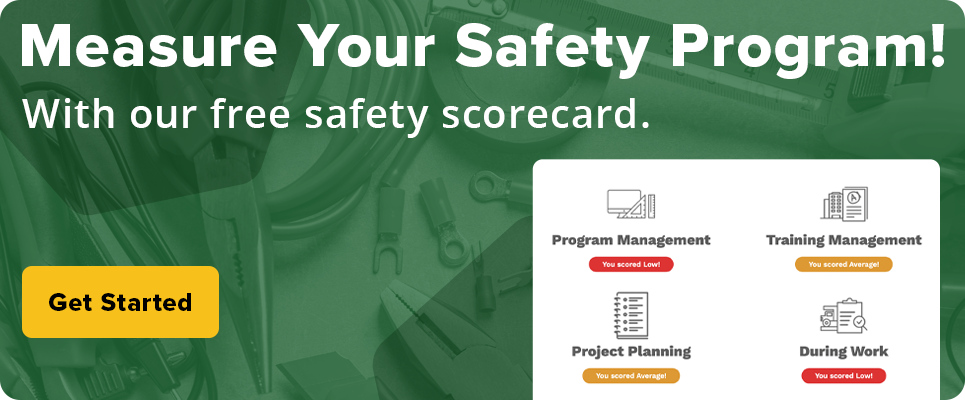
Every June, construction companies across the country take part in National Safety Month.
This annual observance allows companies to renew their focus on protecting crews, preventing injuries and reinforcing a culture of safety as a priority.
But in 2025, the stakes feel even higher.
With labor shortages persisting and project timelines growing tighter, construction crews are under more pressure than ever.
And in an industry where a single moment of distraction can lead to serious consequences, safety can’t take a backseat.
According to the Bureau of Labor Statistics, construction continues to account for one of the highest rates of workplace injuries in the U.S., with over 169,000 recordable injury cases in 2023 alone.
It’s a sobering reminder that even small improvements can have a big impact.
Still, even as construction safety awareness grows and technologies evolve, many companies struggle to maintain construction safety practices across all their jobsites.
Why? Because safety doesn’t exist in isolation, it’s woven into the fabric of how teams communicate, operate and support one another in the field.
Key Takeaways for Construction Health and Managers:
- True safety success comes from everyone on the jobsite, from the crew to leadership, taking ownership and feeling empowered to speak up and contribute to a secure environment.
- Even with good intentions, outdated, manual safety tracking can create dangerous communication gaps.
- Digital safety management platforms are key to streamlining processes, turning inspection data into actionable insights and giving every worker a voice in protecting themselves and their team.
- Digital safety solutions for construction can make safer practices easier to follow, document and trust, ultimately building a safer future together.
Safety Is More Than Compliance
For many contractors, safety efforts begin with compliance — handling OSHA requirements, completing training modules and making sure paperwork is in place.
But staying compliant with government safety regulations and construction safety standards is only the foundation.
True construction safety goes deeper than basic workplace safety programs. It requires daily habits, engaged leadership and an environment where worker safety is empowered.
The National Safety Council’s 2025 campaign theme — “Safety: It’s Everyone’s Business” — reflects broader safety awareness campaigns that emphasize collective responsibility.
It’s a call to move beyond checklists and mandates toward a collaborative mindset where every person, from field crews to office staff, takes ownership of safety outcomes.
Think about it: safer construction jobsites aren’t just about avoiding trouble; they actually drive productivity forward.
When looking to improve your construction health and safety management program, workers who feel safe are more focused, more confident and more likely to complete tasks without interruption.
And companies that prioritize safety see better retention, fewer project delays and stronger reputations with clients and subcontractors alike.
Closing the Gap Between Safety Goals and Daily Reality

Construction companies often struggle to bridge the gap between safety intentions and daily jobsite reality.
Fostering a safety culture in your construction business doesn’t mean accidents never happen.
It means companies are constantly learning, adjusting and investing in construction safety protocols that help crews make better decisions in the moment.
But this is where many organizations hit a wall.
With multiple crews across different jobsites, real-time safety tracking for inspections, incident reports and Toolbox Talks can feel overwhelming, especially if much of that data lives on paper or scattered across inboxes.
Even with the best intentions, it’s easy for communication gaps to grow.
In 2024, a report from Dodge Construction Network titled Safety Management in the Construction Industry found that over 60% of contractors still rely on manual methods — like paper forms or spreadsheets — to document safety activities.
And nearly half said that inconsistent field reporting was one of their biggest obstacles to improving safety performance.
That’s a problem.
Because when construction safety data is delayed, disconnected or incomplete, the risk of repeated incidents increases.
How to Make This Construction Safety Month Count
OSHA data reveals construction accidents caused 20% of workplace fatalities in 2023.
Keeping workers safe and protected is a legal mandate across the United States, which is why there is a critical need for safety measures.
To prevent construction injuries and reduce construction accidents, use National Safety Month as a time to take stock of what’s working and what needs to change.
That might mean revisiting training protocols, updating hazard identification procedures or simply checking in with field teams to understand where support is most needed.
But don’t stop at reflection — use this month to set specific, construction safety initiatives.
Start by auditing your most common jobsite safety reports, with questions like:
- Are near-miss incidents being tracked and reviewed regularly?
- Are toolbox talks happening consistently, and are they actually resonating with crews?
It’s also a good time to refresh construction safety training content to make it more engaging.
Shorten lengthy sessions, incorporate visuals or break topics into weekly themes aligned with National Safety Month,like personal responsibility, equipment safety or mental well-being.
Additionally, engage supervisors to lead by example.
Employee buy-in can set the tone for the entire team. Encourage them to not only enforce safety procedures but also model proactive behaviors, like submitting their own safety observations or giving recognition when workers take initiative.
By introducing small, intentional improvements throughout June, you lay the groundwork for long-term change and create the kind of safety culture that lasts well beyond a single month.
The good news is that the future of safety in construction is being shaped by connectivity — digital safety management systems bring clarity to chaos, turn inspections into insights and give every worker a voice in protecting themselves and their teams.
And while no single safety app with essential features or initiative can transform a jobsite overnight, the right tools can make safer practices easier to follow, easier to document and easier to trust.
See How You Can Turn Awareness Into Action With SafetyHQ®
SafetyHQ transforms safety awareness into measurable jobsite improvements.
Built specifically for the construction industry, SafetyHQ, the health and safety management app, helps contractors turn their safety goals into real-world impact.
From mobile safety forms and inspections to real-time incident tracking and a massive library of safety resources, it’s a smarter way to keep teams connected, compliant and protected — both during National Safety Month and every other month of the year.
So, as you reflect on National Safety Month, ask yourself: What will you do differently this year to create safer jobsites?
Let’s build a safer future, together. Contact us today to learn more!
Share Article
Keep on current news in the construction industry. Subscribe to free eNews!





